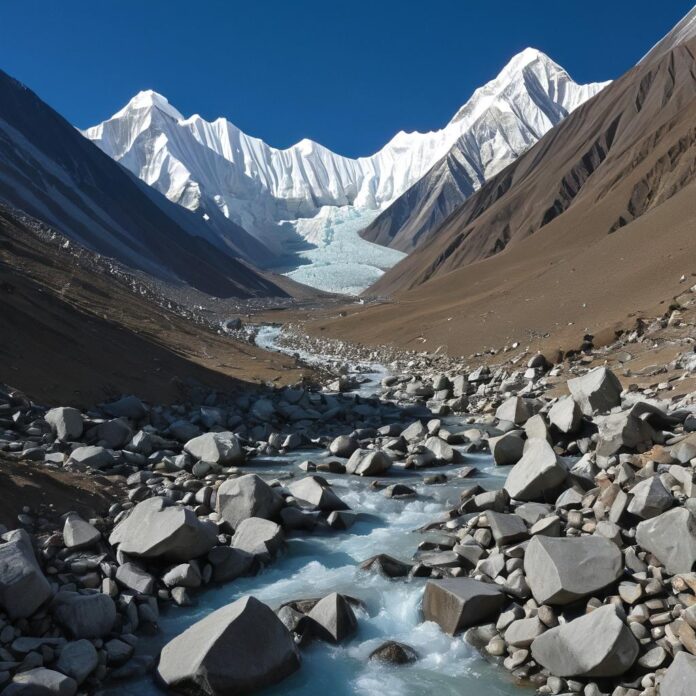Unlike older mountain ranges, such as the Appalachians or the Urals, the Himalayas are relatively young in geological terms

Manoj Kumar Pathak
The majestic Himalayan mountain range, often referred to as the roof of the world, is not just a geographical wonder but also a crucial ecological treasure. However, in recent years, this pristine ecosystem has been under severe threat due to human interventions, particularly in the form of ill-suited development projects. Despite numerous warnings and tragic events like the 2013 Uttarakhand flash floods, the government’s insistence on pursuing projects in the Himalayas continues unabated. This article delves into the perils of such endeavors and emphasizes the urgent need for a paradigm shift towards sustainable practices to safeguard this delicate ecosystem.
The Himalayas, with their towering peaks, deep valleys, and diverse flora and fauna, constitute a unique and sensitive ecosystem. These mountains are not just geological formations but also serve as the source of numerous perennial rivers that sustain millions of lives downstream. However, the very characteristics that make the Himalayas awe-inspiring also make them inherently vulnerable to human interference.
One of the primary reasons behind the fragility of the Himalayan ecosystem is its geological composition. Unlike older mountain ranges, such as the Appalachians or the Urals, the Himalayas are relatively young in geological terms. This youthfulness renders them geo-dynamically active, with constant tectonic movements shaping the landscape. As a result, the region is prone to earthquakes, landslides, and other natural calamities.
Furthermore, human activities, particularly deforestation and unplanned construction, have exacerbated the vulnerability of the Himalayas. Forests act as natural barriers against soil erosion and landslides, but widespread deforestation has stripped the mountainsides bare, leaving them susceptible to erosion and degradation. Moreover, poorly planned infrastructure projects have further destabilized the fragile ecosystem, disrupting natural drainage patterns and exacerbating the risk of disasters.
The 2013 flash floods in Uttarakhand stand as a stark reminder of the consequences of unchecked human intervention in the Himalayas. Triggered by heavy rainfall and exacerbated by deforestation and unregulated construction, the floods wreaked havoc across the region, causing loss of lives and extensive damage to infrastructure and livelihoods.
One of the most glaring examples of ill-suited projects in the Himalayas is the Phata Byung project, which was almost completely washed away by the 2013 floods. Despite this disastrous outcome, the government is keen on reviving the project, highlighting a concerning disregard for the lessons of the past. The insistence on pursuing such projects reflects a shortsighted approach that prioritizes short-term gains over long-term sustainability.
In addition to human activities, the Himalayan ecosystem is also under threat from the impacts of climate change. The region is experiencing rapid warming, with temperatures rising at a faster rate than the global average. This warming trend has far-reaching consequences, including the melting of glaciers, altered precipitation patterns, and increased frequency of extreme weather events.
The Himalayas act as a natural barrier against the southward movement of moisture-laden air masses, playing a crucial role in regulating the climate of the Indian subcontinent. However, rising temperatures in the region are disrupting this delicate balance, leading to erratic weather patterns and increased instances of extreme weather events such as heavy rainfall, flash floods, and landslides.
To ensure the long-term viability of the Himalayan ecosystem, there is an urgent need to adopt a more holistic and sustainable approach to development. This entails integrating environmental considerations into all stages of project planning and implementation, as well as promoting conservation and restoration efforts.
First and foremost, there is a need for stricter regulatory mechanisms to govern development activities in the Himalayas. Environmental impact assessments must be conducted rigorously, taking into account the unique characteristics of the region and the potential risks associated with proposed projects. Furthermore, community participation and consultation should be prioritized to ensure that local perspectives and traditional knowledge are incorporated into decision-making processes.
Additionally, efforts should be made to promote sustainable livelihoods that are compatible with the fragile Himalayan ecosystem. This could involve incentivizing eco-tourism, promoting organic farming practices, and investing in renewable energy sources such as hydropower and solar energy.
The Himalayas, with their breathtaking beauty and ecological significance, are facing unprecedented threats from human activities and climate change. The recurring disasters and environmental degradation witnessed in the region serve as a sobering reminder of the urgent need for action. It is imperative that we learn from past mistakes and adopt a more responsible and sustainable approach to development in the Himalayas. Only through concerted efforts to preserve and protect this fragile ecosystem can we ensure a sustainable future for generations to come.
*******************


